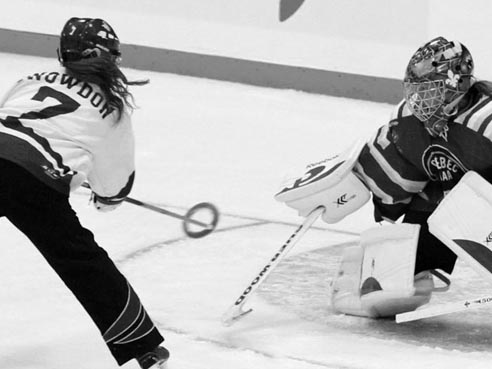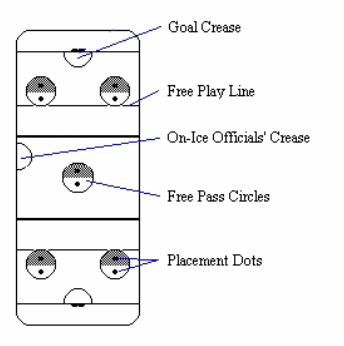What is Ringette?
What is Ringette?

There are a number of common violations that occur throughout a game. These typically result in possession of the ring being awarded to the other team. Possession can be awarded via a "free pass" or a "goalkeeper ring" depending on circumstance. Common violations include:
• Blue Line - The ring must be passed, shot with the stick, deflected, batted, or legally kicked to another player across each blue line. "Legally kicked" means with the side of the skate (not the tip of the blade).
• Two Blue Line Pass - The ring may not be passed to a teammate directly across both blue lines without the ring being contacted first by an opponent.
• Free Play Line ("4 in the zone") - A maximum of 3 players are allowed (from each team) in the "restricted area" in each end zone. The "restricted area" is between the end boards of the rink and the "free play" line, which is the thin red line at the top of the "free play" circles. During goalkeeper substitution this rises to 4 and when serving two penalties this drops to 2.
 • Free Pass - The player taking the free pass must, using the stick, put the ring into play entirely outside the free pass circle within 5 seconds. No other players are allowed within the free pass circle during the free pass.
• Free Pass - The player taking the free pass must, using the stick, put the ring into play entirely outside the free pass circle within 5 seconds. No other players are allowed within the free pass circle during the free pass.• Goal Crease - The goalkeeper is the only player permitted in the goal crease. No other player may contact the ring unless it is entirely outside the goal crease. If anything (stick, skate, ring) is touching the crease line it is considered "in the crease".
Note that some violations such as Goal Crease Free Play Line & can be "delayed" meaning that they were committed by the team not in possession of the ring. In this case, if the offending team does not gain possession within 5 seconds then the violation is waived. This helps to keep the game moving and means that you may see violations occur without play being stopped.
Penalties may also occur throughout the game. Penalties are not often called during house league games but will be called during travel games. Minor penalties are 2 minutes and are typically cancelled by a goal. They can also be "delayed" but are not subject to a 5 second waiver like some violations. Similar to hockey, there are about 10 to 15 different penalties, however, some of the more common penalties are:
• Tripping - Using the stick or any part of the body to cause an opponent to fall. This includes a player sliding along the ice causing an opponent to trip or fall.
• High sticking - Player raises their stick above standing shoulder height (even during a stoppage in play if within a stick length of another on-ice participant).
• Body Contact - Player uses any part of the body to contact an opponent in a forceful manner.
• Boarding - Player uses the body to force an opponent into contact with the boards.
